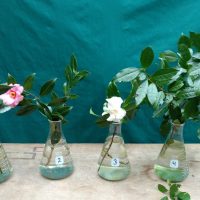Glimpse into the past – an old pond and a new garden in the works

When visiting the Washington Park Arboretum on a regular basis, it is usually not evident that changes occur in both the plants themselves as well as the land forms. However it is easy to see when you compare the photographs over a period of years. This is particularly true when there is water movement involved.
This summer, there will be a new garden constructed near the large southern-most pond along Azalea Way.
May Brings Forth Selected Cuttings from the Pacific Connections Garden at the Washington Park Arboretum

1) Aristotelia chilensis Macqui
This small evergreen tree is native to the Valdivian temperate rainforest of Chile and Argentina.
This inconspicuous white flower yields a small black fruit, and is sometimes called Macqui or, Chilean Wineberry.
This plant and New Zealand’s Mountain Wineberry (A. fruticosa) can both be found in the Pacific Connections Garden.
2) Prostanthera cuneata Alpine Mint Bush
This evergreen shrub is native to southeastern Australia.
Read moreGlimpse into the past – the Master Gardener Plant Sale

During the first weekend in May 2017, the Master Gardener Foundation of King County held its annual Spring Plant Sale and Garden Market on the grounds of the Center for Urban Horticulture. As I browsed the vendors displaying plants and other garden art, I was impressed as to how much has changed as well as how much is still the same.
Read moreSelected Cuttings from the Washington Park Arboretum in May 2017

1) Azara lanceolata
This large shrub is native to Chile and Argentina.
In spring, it is covered with fragrant yellow flowers.
Azara lanceolata can be found near parking lots #4 and #5 along Arboretum Drive.
2) Cytisus x praecox Broom
C. multiflorus x C. purgans
Pale yellow flowers are produced in axillary clusters.
Many Brooms and related plants are blooming now along Arboretum Drive in our legume collection.
Spring – Better Late Than Never!

1) Acer palmatum ‘Beni-maiko’ Japanese Maple
The name Beni-maiko means “red dancing girl”, referring to the brilliant red-to-pinkish foliage that emerges in the spring.
This tree’s current color stands out vibrantly in the Woodland Garden.
Beni-maiko has been recognized by the Royal Horticulture Society and given the Award of Garden Merit for several recent years.
2) Erica arborea Tree Heath/Giant Heather
Erica arborea is native to Africa, having populations in the Ethiopian Highlands, mountains of Ruwenzori, and the Cameroon Mountains.
Read more“Pretty please, with a cherry on top!”

The following are five of the best flowering cherries suitable for growing in the Pacific Northwest. All have good resistance to brown rot blossom blight disease and are good choices size-wise for the home garden. All specimens below are currently in some stage of flowering along our historic Azalea Way Promenade.
1) Prunus x yedoensis ‘Akebono’ Daybreak Yoshino Cherry
‘Akebono’ (“Daybreak”) – This form has pinker flowers than the original Yoshino-type, and the petals are more frilled.
Read moreSelected Cuttings from the Washington Park Arboretum

1) Acer triflorum Three Flower Maple
A small, slow-growing deciduous 20’ to 45’ tree, where it is native to Manchuria and Korea. An excellent landscape tree boasting light-grey vertically furrowed bark and vivid red and orange fall color. The specific epithet makes reference to its flowers, which are borne in clusters of three.
This tree was discovered by noted plant explorer, Ernest H.
Spring Arrives at the Washington Park Arboretum

1) Cornus mas Cornelian Cherry
A native of Europe, C. mas has been cultivated for centuries in Britain. Flowers are produced in February and March on the leafless stems in short-stalked umbels from the joints of the previous year’s wood.
Oblong-ellipsoid, fleshy, bright red fruit are produced in late summer, and are edible when ripe.
Found throughout the Arboretum, these shrubs or small trees are easily identified at this time.
Spring in the Arboretum

The calendar says it’s spring, but what does Nature say? Discover the answer with a stroll through the Washington Park Arboretum.
Read more